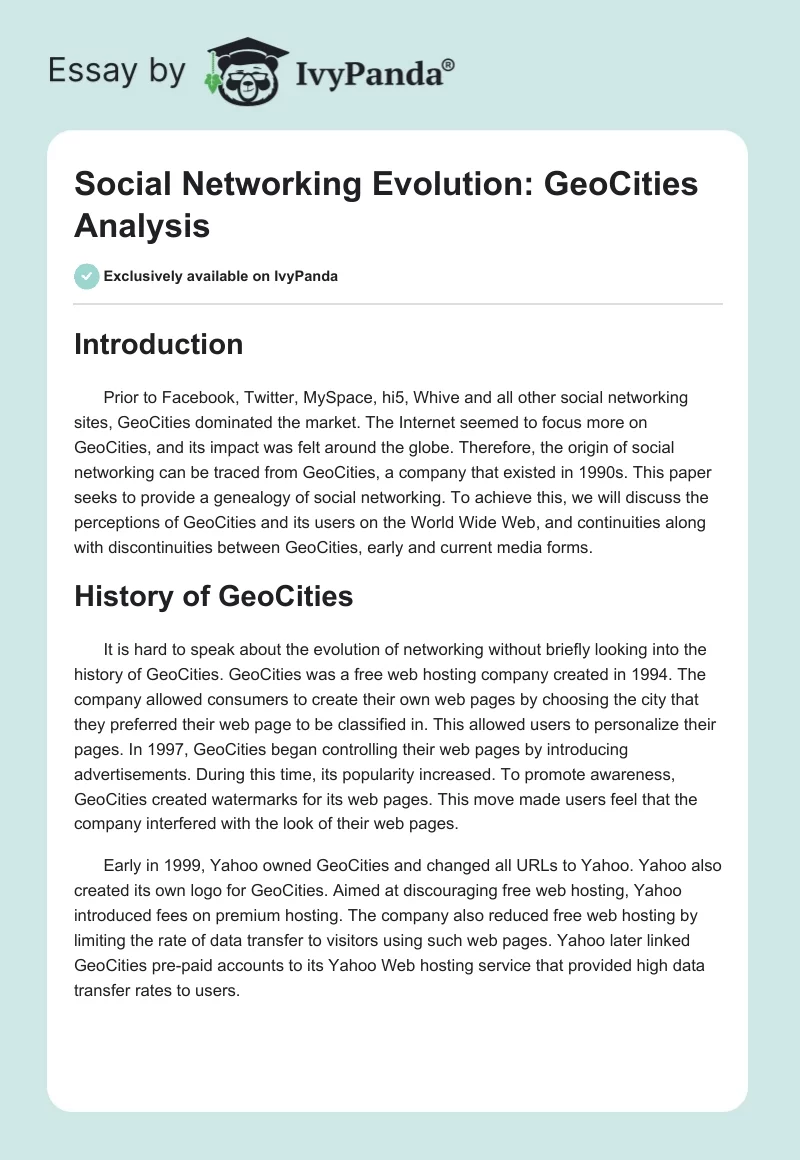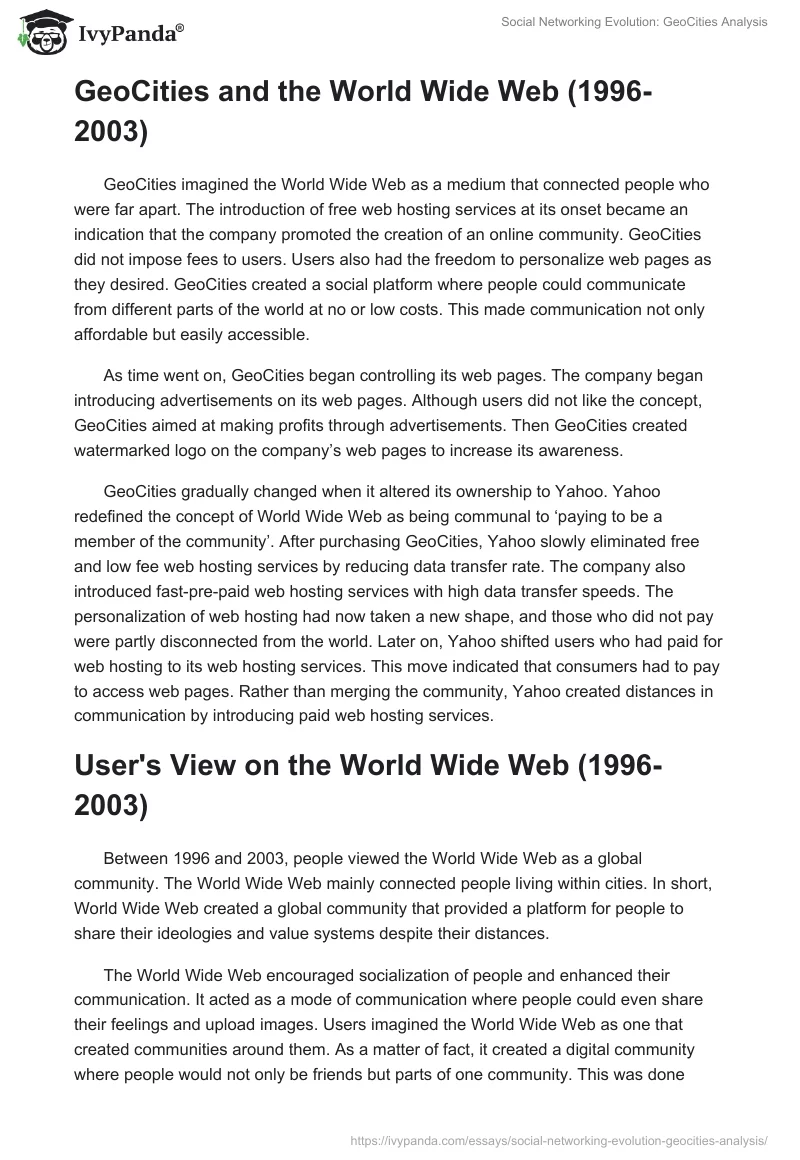Introduction
Prior to Facebook, Twitter, MySpace, hi5, Whive and all other social networking sites, GeoCities dominated the market. The Internet seemed to focus more on GeoCities, and its impact was felt around the globe. Therefore, the origin of social networking can be traced from GeoCities, a company that existed in 1990s. This paper seeks to provide a genealogy of social networking. To achieve this, we will discuss the perceptions of GeoCities and its users on the World Wide Web, and continuities along with discontinuities between GeoCities, early and current media forms.
History of GeoCities
It is hard to speak about the evolution of networking without briefly looking into the history of GeoCities. GeoCities was a free web hosting company created in 1994. The company allowed consumers to create their own web pages by choosing the city that they preferred their web page to be classified in. This allowed users to personalize their pages. In 1997, GeoCities began controlling their web pages by introducing advertisements. During this time, its popularity increased. To promote awareness, GeoCities created watermarks for its web pages. This move made users feel that the company interfered with the look of their web pages.
Early in 1999, Yahoo owned GeoCities and changed all URLs to Yahoo. Yahoo also created its own logo for GeoCities. Aimed at discouraging free web hosting, Yahoo introduced fees on premium hosting. The company also reduced free web hosting by limiting the rate of data transfer to visitors using such web pages. Yahoo later linked GeoCities pre-paid accounts to its Yahoo Web hosting service that provided high data transfer rates to users.
GeoCities and the World Wide Web (1996-2003)
GeoCities imagined the World Wide Web as a medium that connected people who were far apart. The introduction of free web hosting services at its onset became an indication that the company promoted the creation of an online community. GeoCities did not impose fees to users. Users also had the freedom to personalize web pages as they desired. GeoCities created a social platform where people could communicate from different parts of the world at no or low costs. This made communication not only affordable but easily accessible.
As time went on, GeoCities began controlling its web pages. The company began introducing advertisements on its web pages. Although users did not like the concept, GeoCities aimed at making profits through advertisements. Then GeoCities created watermarked logo on the company’s web pages to increase its awareness.
GeoCities gradually changed when it altered its ownership to Yahoo. Yahoo redefined the concept of World Wide Web as being communal to ‘paying to be a member of the community’. After purchasing GeoCities, Yahoo slowly eliminated free and low fee web hosting services by reducing data transfer rate. The company also introduced fast-pre-paid web hosting services with high data transfer speeds. The personalization of web hosting had now taken a new shape, and those who did not pay were partly disconnected from the world. Later on, Yahoo shifted users who had paid for web hosting to its web hosting services. This move indicated that consumers had to pay to access web pages. Rather than merging the community, Yahoo created distances in communication by introducing paid web hosting services.
User’s View on the World Wide Web (1996-2003)
Between 1996 and 2003, people viewed the World Wide Web as a global community. The World Wide Web mainly connected people living within cities. In short, World Wide Web created a global community that provided a platform for people to share their ideologies and value systems despite their distances.
The World Wide Web encouraged socialization of people and enhanced their communication. It acted as a mode of communication where people could even share their feelings and upload images. Users imagined the World Wide Web as one that created communities around them. As a matter of fact, it created a digital community where people would not only be friends but parts of one community. This was done through the establishment of GeoCities, a social networking web hosting company that provided a platform for people to sign up on different cities. When a person joined a city, they met strangers with common interests. Neighborhood ideology was built through the creation of digital communities among residents of the same geographical locations.
An example is the GeoCities web archive, Possum Jenkins Live at Pleasant Ridge House Concerts (2013). The owner created the web page and personalized all their contents. The web page was an exemplary audio archive that recorded individual audio files. One listened to audio files by just clicking icons. The page further provided visitors with options to review, rate and comment on the page. Visitors were also able to download audio files.
People in the same digital communities were able to read the same posts and sign the same guest books. Users were not restricted to access information about their cities. When one joined a city, they became part and parcel of it. The World Wide Web was influential in connecting people who shared common communal values and interests. The World Wide Web had created a platform where people sharing the same interests and core values could communicate.
Personalizing of web pages was also a common phenomenon. People employed the use of layout, graphics and color on their customized web pages to communicate to others in the cities (Gauntlett, 2000). An example of a personalized GeoCities is an animated cartoon on boxing, Boxing tonight (2010). The owner of the webpage created a video clip of animated cartoon on boxing and uploaded it on own webpage. The producer also provided a downloading option. Through GeoCities, the World Wide Web enhanced communication between people.
GeoCities and Older Media Forms
Older media forms included AOL, a web hosting company that preceded the World Wide Web. AOL introduced online services in 1980’s. It used proprietary software and graphical Interface to emphasize communication among its members. In its contribution to the online world, AOL started by offering online games through its software PlayNet.
Tripod was a web hosting company that offered free and paid services in early 1990s. The company also had a blogging tool and a site builder for page editing. Users who paid for the services accessed domain names, additional disk space, email and the web. There was continuity between older media forms and GeoCities. Both AOL and Tripod provided a platform for users to relate to each other. Tripod, just like GeoCities, created a digital community by providing its users with free web hosting services. It also offered blogging and interactive services for users. This feature was continued in GeoCities. GeoCities proceeded to reward those who paid for services with better and unique web hosting services. There was a discontinuity in the usage of software systems to provide online services in the GeoCities period.
GeoCities and the Current Web Culture
Both GeoCities and the current web culture have a platform that allows people to design the look of their web pages and share information. The current web culture continues to display similar characteristics with GeoCities. This has created continuity in the transformation of social media. GeoCities offered users the freedom to upload content to their web pages and create animation. Likewise, the new generation social networking sites have options that allow users to create animations, upload and share pictures with the online community. The two social sites create a room for exchanging information and ideas among people.
However, the development of social networking has seen the creation of discontinuities between GeoCities and the current web culture. Unlike in GeoCities, the current web culture does censor information, including video and visual elements posted. Social networking sites monitor and censor information sent through their web pages. The current web culture has also advanced its tools to include a user’s needs. Users used customized tools to effect changes in their web pages. For example, Boxing tonight (2010), a GeoCities webpage, was customized to fit into the demands of the creator. The owner uploaded audio and video files up to the quantity that satisfied them, and shared the files with friends. The files could also be downloaded.
The current web culture is stricter on the content being shared among users. In short, communication is censored to fit into the web hosting company’s ethical and social standard. Facebook, a recent social networking site, does not give complete freedom to its users. Content posted on its web pages is censored, and in some cases, if an attachment or a file does not satisfy the company’s requirements, it is removed from public view. We encounter words like ‘the attachment is no longer available. It has been flagged as abusive and offensive’. This indicates that communication between people is monitored through various channels, a culture that was not practiced by GeoCities.
The current web culture determines relationships among people. Connection between two people has to be accepted by either party through sending a friend request. Facebook, for example, permits its users to block or add friends. It is possible for someone to add a friend and block them from accessing particular information on their web pages. This is a new development that discontinues the culture in GeoCities that allowed all people of a city to share and access information without limitations.
Development of social networking from GeoCities to the current web pages has seen a tremendous increase in users pay. Today, all users on any social networking sites pay for the Internet. In fact, uploading and downloading audio and visual files are more expensive. The communication between people has also been diversified by the introduction of numerous social networking websites that cater to the same purpose.
Conclusion
Social networking through the Internet dates back to the introduction of AOL and online games. With the lapse of time, social networking culture has developed, and global communities have been created. GeoCities made tremendous changes to the Internet and created digital communities.
Works Cited
Boxing tonight, Prod. Camilo Sidabitbal. Cartoon Animations. 2010. Web.
Gauntlett, David. (2000). Web Studies: Rewiring Media Studies for the Digital Age. London, Arnold. Print.
Possum Jenkins Live at Pleasant Ridge House Concerts, Prod. Glenn Dale. 2013. Web.


